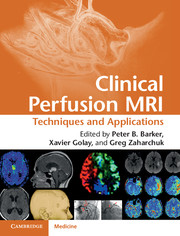Book contents
- Frontmatter
- Contents
- List of Contributors
- Foreword
- Preface
- List of Abbreviations
- Section 1 Techniques
- Section 2 Clinical applications
- 8 MR perfusion imaging in neurovascular disease
- 9 MR perfusion imaging in neurodegenerative disease
- 10 MR perfusion imaging in clinical neuroradiology
- 11 MR perfusion imaging in oncology: neuro applications
- 12 MR perfusion imaging in oncology: applications outside the brain
- 13 MR perfusion imaging in breast cancer
- 14 MR perfusion imaging in the body: kidney, liver, and lung
- 15 MR perfusion imaging in cardiac diseases
- 16 MR perfusion imaging in pediatrics
- Index
- References
14 - MR perfusion imaging in the body: kidney, liver, and lung
from Section 2 - Clinical applications
Published online by Cambridge University Press: 05 May 2013
- Frontmatter
- Contents
- List of Contributors
- Foreword
- Preface
- List of Abbreviations
- Section 1 Techniques
- Section 2 Clinical applications
- 8 MR perfusion imaging in neurovascular disease
- 9 MR perfusion imaging in neurodegenerative disease
- 10 MR perfusion imaging in clinical neuroradiology
- 11 MR perfusion imaging in oncology: neuro applications
- 12 MR perfusion imaging in oncology: applications outside the brain
- 13 MR perfusion imaging in breast cancer
- 14 MR perfusion imaging in the body: kidney, liver, and lung
- 15 MR perfusion imaging in cardiac diseases
- 16 MR perfusion imaging in pediatrics
- Index
- References
Summary
Introduction
This chapter will discuss body perfusion MRI applications, specifically related to three organs: kidneys, liver, and lungs. Each section begins with a short description of the scientific and/or clinical rationale for perfusion imaging and then describes what is known to date regarding the feasibility and/or status of performing these measurements, along with their potential significance. Unlike neurological and oncological applications described in Chapters 8–13, perfusion MRI in the body is still evolving, and so no specific, standardized methods of data acquisition and analysis have yet emerged. However, a brief description of all methods available to date and relevant references are provided. The perfusion MRI techniques discussed fall under two primary categories, either those based on exogenous contrast agent administration, or those based on endogenous contrast mechanisms.
Kidney
Scientific/clinical rationale
In 1938, Goldblatt [1, 2] demonstrated a relationship between hypertension and renal ischemia. He was able to consistently produce elevations in systolic blood pressure by producing renal ischemia with a constricting clamp in an animal model. Removal of the clamp restored blood pressure to the reference range. Based on this finding, Burkland et al. performed nephrectomy of a unilateral ischemic kidney as a cure for hypertension [3]. This remained the method of surgical treatment until 1960 when Lambeth et al. reported resolving hypertension by correction of renal artery stenosis (RAS) [4]. In the 1960s, the delineation of the renin–angiotensin system and its relation to hypertension [5] also had a large impact on the medical therapy and diagnostic studies used in renovascular hypertension.
- Type
- Chapter
- Information
- Clinical Perfusion MRITechniques and Applications, pp. 281 - 301Publisher: Cambridge University PressPrint publication year: 2013



